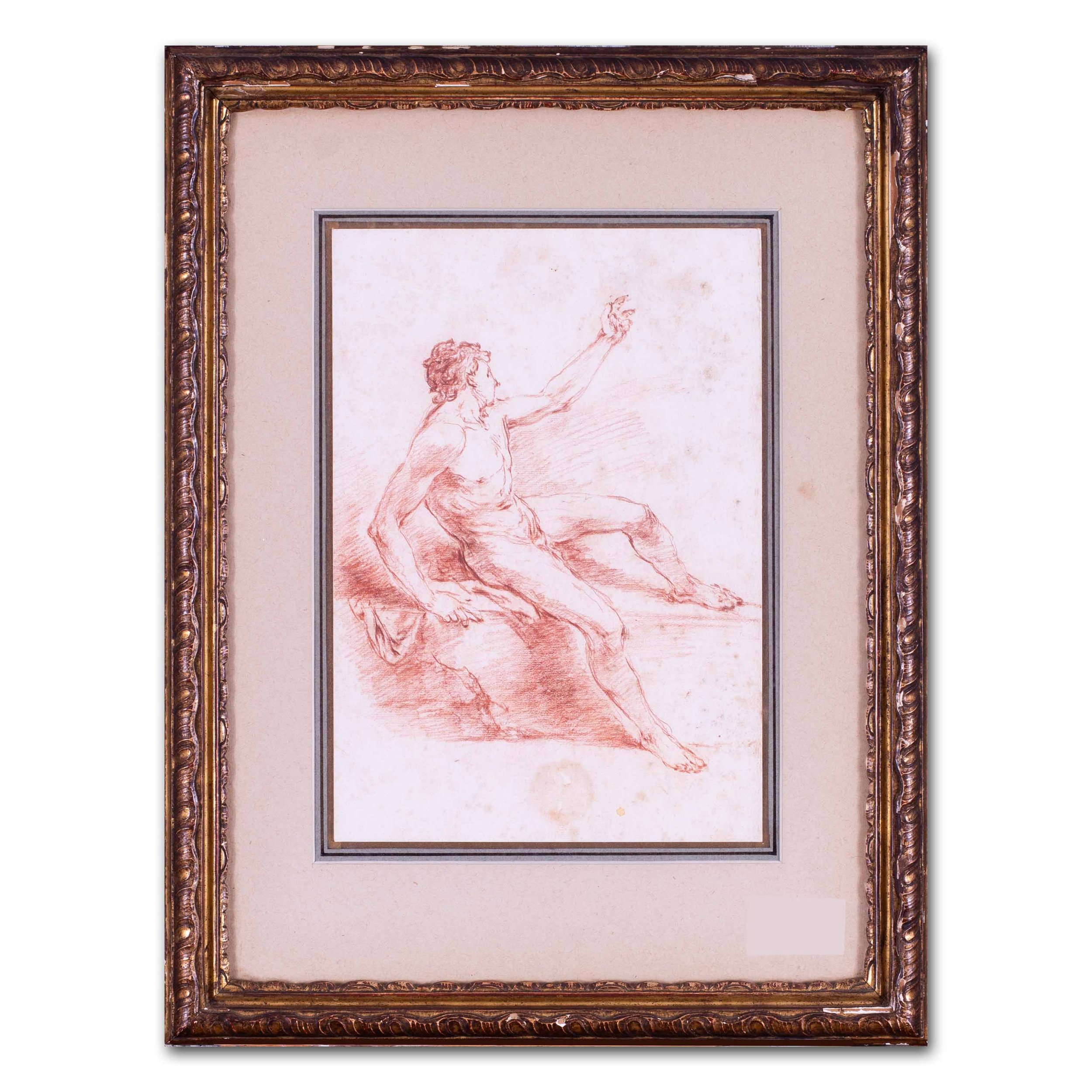Francesco Zuccarelli RA, 'Study of a seated man '
Francesco Zuccarelli RA (Italian, 1702-1788)
Study of a seated man
Red chalk
11.1/8 x 7.5/8 in. (28.3 x 19.3 cm.)
Provenance; Colnaghi & Co, London
Francesco Zuccarelli was born in Pitigliano, Italy in 1702. At a very young age he moved to Rome, where he studied under several painters and eventually specialized in landscape. He then spent time in Florence before settling in Venice in the 1730s, where he became celebrated for his pastoral scenes. There Zuccarelli enjoyed the patronage of numerous Englishmen on the Grand Tour. The British consul Joseph Smith was also an important patron for Zuccarelli during this period, as he was for another Venetian painter, Canaletto. Zuccarelli moved to London in 1752, following in the footsteps of Canaletto (who was in England between 1746 and 1755). Smith, who helped Canaletto sell his paintings to English clients, may have influenced Zuccarelli in this decision to move to a country where there was already a strong demand for the artist’s work. The artist Richard Wilson, whom Zuccarelli met in Venice in 1751, may also have recommended the move. Zuccarelli returned to Italy in the early 1760s, but was back in London by 1765, exhibiting that year at the Free Society. He was one of twenty-two artists who petitioned King George III to found a new academy in 1768, and became a Founding Member when the Royal Academy of Arts was established shortly afterwards. The King also commissioned paintings from him including The Finding of Moses (1768; Royal Collection). In Johan Zoffany’s group portrait The Academicians of the Royal Academy (1771-2; Royal Collection) Zuccarelli is placed in a prominent position directing the Keeper (Director) of the RA Schools, George Michael Moser, who sets the life model. Zuccarelli last exhibited at the Royal Academy in 1773 and returned to Italy the following year, settling in Florence where he died in 1788.
Francesco Zuccarelli RA (Italian, 1702-1788)
Study of a seated man
Red chalk
11.1/8 x 7.5/8 in. (28.3 x 19.3 cm.)
Provenance; Colnaghi & Co, London
Francesco Zuccarelli was born in Pitigliano, Italy in 1702. At a very young age he moved to Rome, where he studied under several painters and eventually specialized in landscape. He then spent time in Florence before settling in Venice in the 1730s, where he became celebrated for his pastoral scenes. There Zuccarelli enjoyed the patronage of numerous Englishmen on the Grand Tour. The British consul Joseph Smith was also an important patron for Zuccarelli during this period, as he was for another Venetian painter, Canaletto. Zuccarelli moved to London in 1752, following in the footsteps of Canaletto (who was in England between 1746 and 1755). Smith, who helped Canaletto sell his paintings to English clients, may have influenced Zuccarelli in this decision to move to a country where there was already a strong demand for the artist’s work. The artist Richard Wilson, whom Zuccarelli met in Venice in 1751, may also have recommended the move. Zuccarelli returned to Italy in the early 1760s, but was back in London by 1765, exhibiting that year at the Free Society. He was one of twenty-two artists who petitioned King George III to found a new academy in 1768, and became a Founding Member when the Royal Academy of Arts was established shortly afterwards. The King also commissioned paintings from him including The Finding of Moses (1768; Royal Collection). In Johan Zoffany’s group portrait The Academicians of the Royal Academy (1771-2; Royal Collection) Zuccarelli is placed in a prominent position directing the Keeper (Director) of the RA Schools, George Michael Moser, who sets the life model. Zuccarelli last exhibited at the Royal Academy in 1773 and returned to Italy the following year, settling in Florence where he died in 1788.
Francesco Zuccarelli RA (Italian, 1702-1788)
Study of a seated man
Red chalk
11.1/8 x 7.5/8 in. (28.3 x 19.3 cm.)
Provenance; Colnaghi & Co, London
Francesco Zuccarelli was born in Pitigliano, Italy in 1702. At a very young age he moved to Rome, where he studied under several painters and eventually specialized in landscape. He then spent time in Florence before settling in Venice in the 1730s, where he became celebrated for his pastoral scenes. There Zuccarelli enjoyed the patronage of numerous Englishmen on the Grand Tour. The British consul Joseph Smith was also an important patron for Zuccarelli during this period, as he was for another Venetian painter, Canaletto. Zuccarelli moved to London in 1752, following in the footsteps of Canaletto (who was in England between 1746 and 1755). Smith, who helped Canaletto sell his paintings to English clients, may have influenced Zuccarelli in this decision to move to a country where there was already a strong demand for the artist’s work. The artist Richard Wilson, whom Zuccarelli met in Venice in 1751, may also have recommended the move. Zuccarelli returned to Italy in the early 1760s, but was back in London by 1765, exhibiting that year at the Free Society. He was one of twenty-two artists who petitioned King George III to found a new academy in 1768, and became a Founding Member when the Royal Academy of Arts was established shortly afterwards. The King also commissioned paintings from him including The Finding of Moses (1768; Royal Collection). In Johan Zoffany’s group portrait The Academicians of the Royal Academy (1771-2; Royal Collection) Zuccarelli is placed in a prominent position directing the Keeper (Director) of the RA Schools, George Michael Moser, who sets the life model. Zuccarelli last exhibited at the Royal Academy in 1773 and returned to Italy the following year, settling in Florence where he died in 1788.







